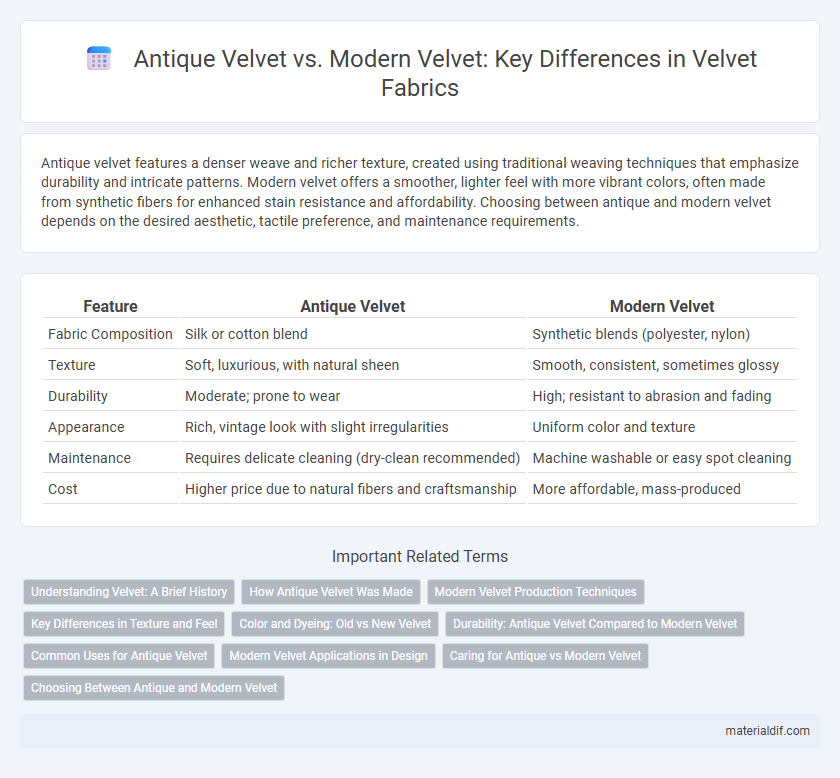Antique velvet features a denser weave and richer texture, created using traditional weaving techniques that emphasize durability and intricate patterns. Modern velvet offers a smoother, lighter feel with more vibrant colors, often made from synthetic fibers for enhanced stain resistance and affordability. Choosing between antique and modern velvet depends on the desired aesthetic, tactile preference, and maintenance requirements.
Table of Comparison
| Feature | Antique Velvet | Modern Velvet |
|---|---|---|
| Fabric Composition | Silk or cotton blend | Synthetic blends (polyester, nylon) |
| Texture | Soft, luxurious, with natural sheen | Smooth, consistent, sometimes glossy |
| Durability | Moderate; prone to wear | High; resistant to abrasion and fading |
| Appearance | Rich, vintage look with slight irregularities | Uniform color and texture |
| Maintenance | Requires delicate cleaning (dry-clean recommended) | Machine washable or easy spot cleaning |
| Cost | Higher price due to natural fibers and craftsmanship | More affordable, mass-produced |
Understanding Velvet: A Brief History
Antique velvet, characterized by its handwoven craftsmanship and natural fibers like silk and cotton, offers a rich texture and patina that reflects centuries of artisanal tradition. Modern velvet incorporates synthetic blends such as polyester and rayon, providing enhanced durability and a wider range of colors and finishes. Understanding the evolution of velvet highlights a transition from exclusive, labor-intensive production to versatile, mass-produced fabrics that maintain the luxurious feel and appearance.
How Antique Velvet Was Made
Antique velvet was traditionally crafted using natural fibers such as silk and mohair, woven on hand-operated looms that created dense, plush textures with subtle variations in pile height. The complex weaving technique involved cutting the pile loops to form a soft, luxurious surface, often enhanced by hand-dyeing with natural pigments for rich, deep colors. This artisanal process resulted in unique, durable fabric prized for its tactile warmth and aesthetic depth, distinguishing it from the more uniform textures of modern machine-made velvet.
Modern Velvet Production Techniques
Modern velvet production techniques leverage advanced weaving technologies such as computerized jacquard looms and synthetic fiber blends, enhancing durability and design precision compared to antique velvet's handwoven silk or cotton base. These innovations allow for diverse textures, faster production rates, and increased cost efficiency, meeting contemporary market demands while preserving the luxurious appearance. Modern velvet often incorporates polyester, nylon, or rayon, optimizing resilience and colorfastness beyond traditional velvet fabrics.
Key Differences in Texture and Feel
Antique velvet features a denser pile and a slightly rougher texture, resulting from traditional weaving techniques that create a rich, tactile surface with natural variations. Modern velvet is typically smoother and more uniform due to advanced manufacturing processes, offering a softer feel and increased durability. The key difference lies in antique velvet's aged, luxurious character versus modern velvet's consistent, plush texture ideal for contemporary designs.
Color and Dyeing: Old vs New Velvet
Antique velvet features natural dyes that create rich, often softer and more muted color tones, showcasing subtle variations and depth due to traditional hand-dyeing methods. Modern velvet utilizes synthetic dyes, resulting in a broader and more vibrant color spectrum, with enhanced colorfastness and uniformity across the fabric. The evolution in dye technology influences the final appearance and aging characteristics of velvet textiles, distinguishing old-world warmth from contemporary brilliance.
Durability: Antique Velvet Compared to Modern Velvet
Antique velvet is prized for its dense cotton or silk weave, which contributes to a luxurious texture but may show wear faster due to less advanced fiber treatments. Modern velvet often incorporates synthetic blends like polyester or viscose, enhancing durability and resistance to abrasion while maintaining a soft feel. The evolution in textile technology allows modern velvet to better withstand heavy use in upholstery and fashion compared to its antique counterpart.
Common Uses for Antique Velvet
Antique velvet is primarily used in restoration projects and period-specific interior design due to its rich texture and authentic appearance. This fabric is favored for upholstering vintage furniture, draperies, and decorative pillows to preserve historical accuracy and add a sense of timeless luxury. Common uses also include theatrical costumes and museum displays where maintaining original textile qualities is essential.
Modern Velvet Applications in Design
Modern velvet, crafted from synthetic fibers like polyester and nylon, offers enhanced durability and stain resistance compared to antique velvet made from natural fibers such as silk and cotton. Its versatility and vibrant color range make it ideal for contemporary furniture upholstery, decorative pillows, and wall coverings in interior design. The fabric's soft texture and sheen create a luxurious ambiance while meeting the practical demands of high-traffic residential and commercial spaces.
Caring for Antique vs Modern Velvet
Antique velvet requires gentle care with specialized upholstery cleaners and minimal water to preserve its delicate fibers and historical value, while modern velvet benefits from more durable synthetic blends that tolerate regular vacuuming and spot cleaning with mild detergents. Avoiding direct sunlight is crucial for both types to prevent fading, but antique velvet often demands professional restoration for stains or wear, whereas modern velvet usually allows for DIY maintenance. Maintaining the texture and color integrity of antique velvet involves controlled humidity environments, contrasting with modern velvet's more robust resistance to everyday handling.
Choosing Between Antique and Modern Velvet
Antique velvet features a heavier weave with rich, muted tones and intricate patterns, ideal for creating a classic, vintage ambiance. Modern velvet typically has a lighter, smoother texture with vibrant colors and minimalist designs, suited for contemporary interiors. Selecting between antique and modern velvet depends on the desired aesthetic, durability, and maintenance requirements of your space.
Antique Velvet vs Modern Velvet Infographic

 materialdif.com
materialdif.com